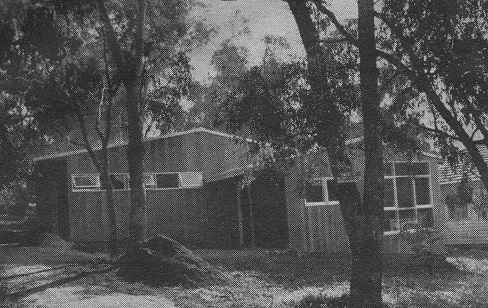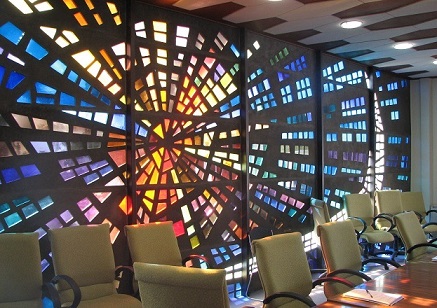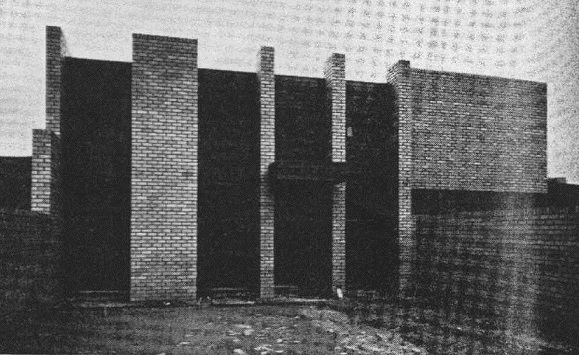Born in Sunshine on 17 February 1922, Gordon Stuart Warmington was one of twin sons of James Warmington (1887-1970) and his wife Alice, nee
Adamson (1884-1936). The elder Warmington, a second cousin
of industrialist H V McKay, emigrated from Ireland in 1910 to take up a
positon at
McKay's Sunshine Harvester Works, which opened only a few years
earlier
in the western suburb of Melbourne that later took its name.
After Alice Warmington's early death in 1936, the family
relocated to Rosanna, where the twins attended Ivanhoe
Grammar School (for which, many years later, Warmington would be
commissioned to write a school history). Matriculating in 1939,
Warmington commenced
the architecture course at Melbourne Technical College, although his
studies were soon interrupted by the Second World War. In May
1941, he and his twin brother Ian (1922-1982) enlisted with the
Australian Army, both
initially serving with the 5th Batallion of the Victorian Scottish
Regiment. Stuart was subsequently attached to the 42 ALC Company
of the Royal Australian Engineers, and was discharged in July 1944 with
the rank of Corporal.
Resuming his architectural training back in Melbourne, Warmington took evening classes at the University of Melbourne Architectural Atelier while working during the day in the office of Oakley & Parkes. In early 1946, he was elected to the committee of the VASS (Victorian Architectural Students' Society). When the society re-launched its popular monthly newsletter, Smudges, Warmington was responsible for distribution until the end of 1947. After completing his studies the following year, Warmington entered the Queens Road office of Frederick Romberg, whom he cites as a key influence in his subsequent career. In Romberg's employ, Warmington worked on a number of significant projects, which included preparing the working drawings for the important (but since demolished) Hillstan flats on the Nepean Highway at Brighton. After leaving Romberg's office around 1950, Warmington went overseas with some other recent graduates. Purchasing an old car, they drove through across the continent, visiting buildings in Spain, France, Sweden and Norway. In England, they attended the Festival of Britain (which opened in May 1951) and Warmington obtained work with an architectural firm where another young Australian architect, Les Perrott, also happened to be employed at the time.
Returning to Melbourne, Warmington became associated with John & Phyllis Murphy, whom he also knew from his students days. According to Warmington himself, he assisted in the operation of the Murphys' private practice while the couple was otherwise engaged on the documentation of the their prize-winning design (with Peter McIntyre, Kevin Borland and Bill Irwin) for the Olympic Swimming Pool. In April 1953, it was reported that Warmington and the Murphys had formally entered into partnership. This appears to have continued for about two years, with one of the last collaborations between the Murphys and Warmington being a house at Ringwood East, for which the drawings are dated January 1955.
Later in 1955, Warmington executed his first independant commission: a house at Greensborough for himself and his wife Rae (1928-2012), whom he married in early 1953. Around the same time, he was approached by the then recently-proclaimed City of Sunshine to undertake a minor project in the absence of the council's usual architects, Armstrong & Orton, whose office had been depleted when several staff travelled overseas. More than satisfied by the result, the Sunshine City Council retained Warmington as its regular architect for over two decades, during which time he worked on over thirty projects for local municipal and community buildings. In 1961, Warmington entered into partnership with architect Anthony William Matthews (1921-2010). This partnership, however, lasted only about a year. Matthews later moved to Canberra, where he took a job with the Department of Works & Housing.
Resuming sole prctice, Warmington was engaged by the Sunshine City Council to prepare an ambitious masterplan for a new civic centre, which was realised in several stages between 1962 and 1967. The building included a coloured glass window of bold geometric design, which represented the work of a young member of Warmington's office, Italian-born Edgard Pirrotta, who later became a noted architect in his own right. Pirrotta was also responsible for an equally striking sculpted mural in another of Warmington's projects in Sunshine: a funeral parlour for Nelson Brothers Ltd. Such was the architect's long and fruitful association with the thriving western suburb of his birth that he was once loftily described by the local newspaper as “the Burley Griffin of Sunshine”.
In later life, Warmington fostered some notable interests outside architectural practice. In the late 1970s, he served as a panel member (alongside former associates John & Phyllis Murphy) on the newly-formed Council for the Historic Environment. Warmington's interest in writing, which dated back to his student days with Smudges, saw him publish a history of his alma mater, titled A Vision Fulfilled: The Ivanhoe Grammar School, the first 70 years (1985), illustrated by his own pen-and-ink drawings. Although he retired from architectural practice in 1987, Warmington remained active as a consultant and was engaged by Australia Post to provide advice on the heritage significance of post offices. He finally retired, fully and permanently, in December 1992. Notwithstanding, Warmington maintained his long-held interest in writing and, as recently as 2007, co-authored (with Don Gibb) a volume of local history, entitled, Visions of a Village: Canterbury Shops and Shopping, 1880s-1990s and beyond.
Resuming his architectural training back in Melbourne, Warmington took evening classes at the University of Melbourne Architectural Atelier while working during the day in the office of Oakley & Parkes. In early 1946, he was elected to the committee of the VASS (Victorian Architectural Students' Society). When the society re-launched its popular monthly newsletter, Smudges, Warmington was responsible for distribution until the end of 1947. After completing his studies the following year, Warmington entered the Queens Road office of Frederick Romberg, whom he cites as a key influence in his subsequent career. In Romberg's employ, Warmington worked on a number of significant projects, which included preparing the working drawings for the important (but since demolished) Hillstan flats on the Nepean Highway at Brighton. After leaving Romberg's office around 1950, Warmington went overseas with some other recent graduates. Purchasing an old car, they drove through across the continent, visiting buildings in Spain, France, Sweden and Norway. In England, they attended the Festival of Britain (which opened in May 1951) and Warmington obtained work with an architectural firm where another young Australian architect, Les Perrott, also happened to be employed at the time.
Returning to Melbourne, Warmington became associated with John & Phyllis Murphy, whom he also knew from his students days. According to Warmington himself, he assisted in the operation of the Murphys' private practice while the couple was otherwise engaged on the documentation of the their prize-winning design (with Peter McIntyre, Kevin Borland and Bill Irwin) for the Olympic Swimming Pool. In April 1953, it was reported that Warmington and the Murphys had formally entered into partnership. This appears to have continued for about two years, with one of the last collaborations between the Murphys and Warmington being a house at Ringwood East, for which the drawings are dated January 1955.
Later in 1955, Warmington executed his first independant commission: a house at Greensborough for himself and his wife Rae (1928-2012), whom he married in early 1953. Around the same time, he was approached by the then recently-proclaimed City of Sunshine to undertake a minor project in the absence of the council's usual architects, Armstrong & Orton, whose office had been depleted when several staff travelled overseas. More than satisfied by the result, the Sunshine City Council retained Warmington as its regular architect for over two decades, during which time he worked on over thirty projects for local municipal and community buildings. In 1961, Warmington entered into partnership with architect Anthony William Matthews (1921-2010). This partnership, however, lasted only about a year. Matthews later moved to Canberra, where he took a job with the Department of Works & Housing.
Resuming sole prctice, Warmington was engaged by the Sunshine City Council to prepare an ambitious masterplan for a new civic centre, which was realised in several stages between 1962 and 1967. The building included a coloured glass window of bold geometric design, which represented the work of a young member of Warmington's office, Italian-born Edgard Pirrotta, who later became a noted architect in his own right. Pirrotta was also responsible for an equally striking sculpted mural in another of Warmington's projects in Sunshine: a funeral parlour for Nelson Brothers Ltd. Such was the architect's long and fruitful association with the thriving western suburb of his birth that he was once loftily described by the local newspaper as “the Burley Griffin of Sunshine”.
In later life, Warmington fostered some notable interests outside architectural practice. In the late 1970s, he served as a panel member (alongside former associates John & Phyllis Murphy) on the newly-formed Council for the Historic Environment. Warmington's interest in writing, which dated back to his student days with Smudges, saw him publish a history of his alma mater, titled A Vision Fulfilled: The Ivanhoe Grammar School, the first 70 years (1985), illustrated by his own pen-and-ink drawings. Although he retired from architectural practice in 1987, Warmington remained active as a consultant and was engaged by Australia Post to provide advice on the heritage significance of post offices. He finally retired, fully and permanently, in December 1992. Notwithstanding, Warmington maintained his long-held interest in writing and, as recently as 2007, co-authored (with Don Gibb) a volume of local history, entitled, Visions of a Village: Canterbury Shops and Shopping, 1880s-1990s and beyond.
Select List of Projects
Stuart Warmington/John & Phyllis Murphy (1953-1955)
| 1953 1954 1955 | Residence, Plenty Road, South Morang Residence, Belford Road, Kew Residence, Angus Road, Croydon Residence, 9 Hume Street (formerly Studley Avenue), Kew Residence, Orchard Crescent, Box Hill North Residence, Dorset Road, Croydon Residence, Hardinge Street, Beaumaris Residence, Normanby Road, Kew Residence, Shirley Avenue, Syndal Residence, Scott Street, Beaumaris Residence, Russett Road, Ringwood East |
Stuart Warmington (1955-1960; 1962)
| 1955 1962 1966 1968 | Residence for self, Alexandra Street, Greensborough Extensions to Town Hall, Sunshine Infant Welfare Centre, Maidstone Masterplan for the Sunshine Civic Centre, Sunshine - Central library and health centre, Sunshine, Wilkinson Street [built 1963-64] - Municipal offices and council chambers, Alexandra Avenue [built 1964-67] Funeral parlour for Nelson Brothers, 51 Devonshire Road, Sunshine Project house for Shawline Seaside Homes Pty Ltd, Thompson Avenue, Cowes |
Warmington & Matthews (1961-1962)
| 1961 1962 | Residence, Martin Street, Heidelberg Residence, Arthurs Creek Road, Yan Yean Flats, Ascot Street, Malvern Residence, Clarke Street, Mount Waverley Residence, Wendy Court, Heathmont |
 | |
| Legge House in Kew (with John & Phyllis Murphy, 1954) |
 | |
| Stuart Warmington's own house, Greensborough (1955) |
 | |
| Perspective drawing of Sunshine Civic Centre (1964-67) |
 | |
| Detail of stained glass window to Sunshine Civic Centre (source: photograph by Built Heritage Pty Ltd, 2010) |
 | |
| Funeral parlour for Nelson Brothers, Sunshine (1966-67) |
 | |
| Project house for Shawline Seaside Homes, Phillip Island |
